A Private Tour today down in the Brecks. After the recent hot weather, it finally broke today. But although we dodged the thunder storms successfully, it was rather cool and windy afterwards, through the afternoon.
On our way down, we stopped off first at Weeting Heath. We were immediately rewarded with lovely views of a Stone Curlew feeding in the long grass in front of the hide. It was quite active, running backwards and forwards, looking down at the ground for food and occasionally pecking at something. A careful scan revealed a second Stone Curlew, sat down hidden in the vegetation – we could just see the back of its head! A Mistle Thrush was hopping around on the shorter grass in front of the hide too.
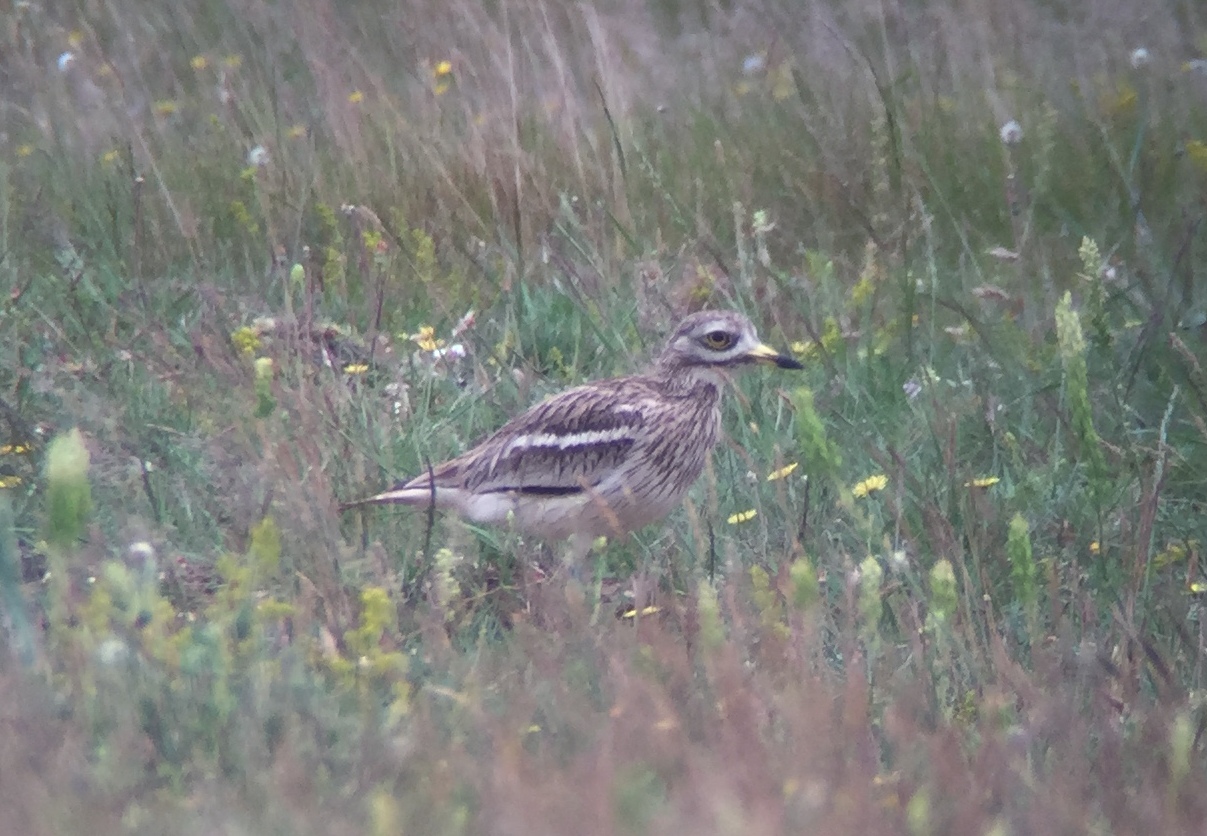 Stone Curlew – showing well at Weeting today
Stone Curlew – showing well at Weeting today
One of the targets for the day was to see summer warblers, so we made our way over to another site where we hoped we might find some. We were duly rewarded with a nice selection. Garden Warbler was a particularly sought after species and we found at least two pairs, one of the males singing briefly. A subtle species, it was good to get a proper look at them, as they can be rather skulking.
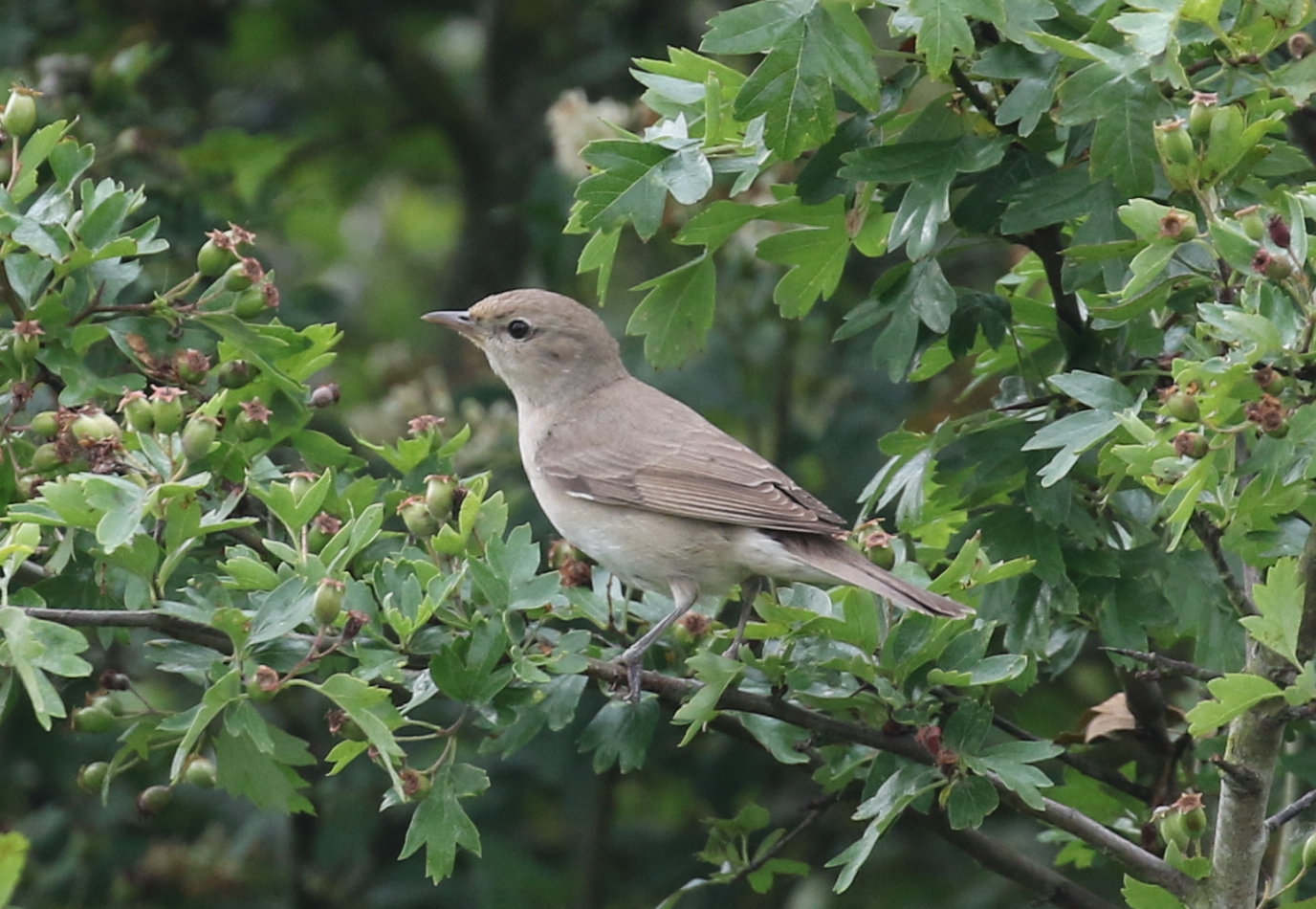 Garden Warbler – we got good views of this species today
Garden Warbler – we got good views of this species today
We also heard and saw several other species here – Blackcap, Common Whitethroat, Willow Warbler and Chiffchaff were all singing and perched around in the bushes. Only Lesser Whitethroat evaded us here – they are present, but probably busy with breeding at the moment and consequently silent and hiding.
This is also a good spot for Nightingale. They were rather quiet at first – it is not the best time of the year to look for them – but we eventually heard one singing. We followed the sound and saw it perched up briefly in a hawthorn. It took a while to get everyone onto it, but thankfully came out onto the same branch again for a second. Then it dropped down out of view. As we continued on round, we heard another Nightingale singing further over and one calling nearby, sounding rather like a frog croaking.
There were a few other birds here too. We flushed several Linnets from the grass and bushes as we walked round. A female Greenfinch flew up in front of us and landed on some brambles, carrying some moss in its bill, presumably busy nest building nearby. We heard a couple of Yellowhammers singing and eventually got a look at one perched on some overhead wires.
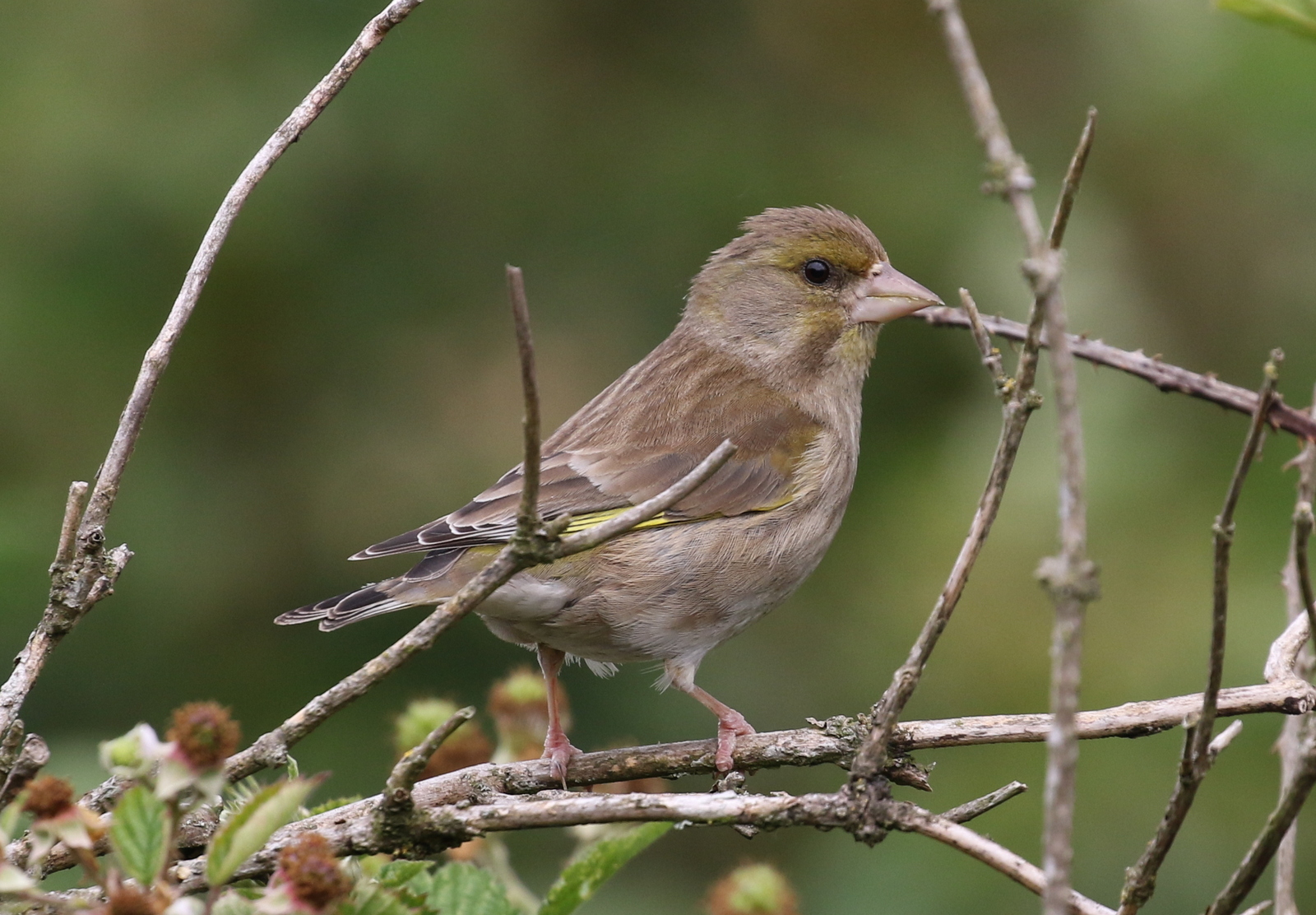 Greenfinch – this female was probably nest building nearby
Greenfinch – this female was probably nest building nearby
We had heard thunder rumbling and dark clouds starting to gather. The lightning when it started was quite dramatic but thankfully some distance away. Finally it started to spit with rain, so we made our way quickly back to the car. We arrived just in time, as the heavens opened.
The rain had stopped by the time we got to Lakenheath Fen, but it was still cloudy and rather cooler than it had been earlier. We headed straight out onto the reserve, with Reed Warblers and Sedge Warblers, and Common Whitethroats all singing by the path and showing well. In contrast, a Cetti’s Warbler shouted from deep in the bushes.
There were a few birds on the pool in front of the New Fen Viewpoint. An adult Great Crested Grebe was being followed round by a well grown juvenile, still boasting a black and white striped face. The family of Coot have almost fully grown young too, but the female Tufted Duck was all alone. A Kingfisher zipped out of the trees behind us and disappeared low across the water, returning the same way a minute or so later with fish in bill. A smart male Marsh Harrier flew across over the reeds at the back.
 Great Crested Grebe – on the pools at New Fen
Great Crested Grebe – on the pools at New Fen
As we continued out along the main path, there were lots of dragonflies by the path. Several male Black-tailed Skimmers were basking on the bare dirt along the track, flying off ahead of us. The vegetation either side was alive with Ruddy Darters today, presumably recently emerged as they seemed to be mostly young males and females. There were butterflies too, with Red Admirals and Small Tortoiseshells on the brambles. A Large Skipper landed briefly beside the path.
 Ruddy Darter – there were lots out today
Ruddy Darter – there were lots out today
On the walk out, we had heard a Cuckoo singing from the poplars in the distance, but it had stopped when we got to New Fen. As we approached the West Wood it flew straight out of the trees towards us and landed in the poplars right by the path. We had a great look at it through the scope, before it flew deeper into the trees and started singing again. A second Cuckoo was still singing in West Wood as we passed.
 Cuckoo – landed in the poplars next to the path briefly
Cuckoo – landed in the poplars next to the path briefly
Continuing on to Joist Fen viewpoint, there were several RSPB volunteers hanging around staring out across the reeds. They were doing a Bittern survey today. It wasn’t long before we spotted a Bittern for them. It flew up out of the reeds in front of the viewpoint and headed off over the channel, before turning and dropping down into the reeds along one side. There was a lot of Bittern activity today – this is a good time to see them, as the adults are making regular feeding flights to and from their nests.
There were plenty of other birds to see at Joist Fen. Several Marsh Harriers were quartering back and forth over the reeds, a Common Tern was fishing over one of the pools and a Cormorant flew up from one of the channels and headed over towards the river. A flock of over 20 Black-tailed Godwits circled over the reedbed. We heard Bearded Tits calling a couple of times but couldn’t see them – it was getting rather breezy now. There was no sign of any Hobbys here today, but it was perhaps rather too cool and windy after the rain, which was keeping all the insects down.
Climbing up onto the river bank, we had a quick scan across the fields opposite, but it was all rather quiet here. Several Mute Swans were feeding along the river, as was another Great Crested Grebe. Looking back across Joist Fen, we spotted another two Bitterns flying across together further over, before splitting off and dropping down again in different directions.
Back at Mere Hide it was more sheltered and there were more dragonflies, with several Four-Spotted Chasers chasing around over the water. A Red-eyed Damselfly landed on a cut reed stem just in front of the hide. A Kingfisher flew in and looked like it might land on one of the posts out in the water but instead carried on past and landed in the reeds right next to the hide. It was partly obscured by the reeds, but we got a great look at it.
 Kingfisher – landed in the reeds right in front of Mere Hide
Kingfisher – landed in the reeds right in front of Mere Hide
Back at New Fen, we stopped by the viewpoint again briefly, but there were still no Hobbys here either. We did see another Bittern, our fourth of the morning, which flew right across low over the reeds and over the river bank, turning and landing just beyond. We walked round there to see if it was close to the path, but when we arrived there was no sign of it.
We made our way back along the river bank to the Washland. It was looking rather dry now, and there were fewer ducks than earlier in the year. We did manage to see a nice selection of waders, including a single Little Ringed Plover, one Redshank, two Black-tailed Godwits and plenty of Oystercatchers & Lapwings. In the distance beyond, e could see a Red Kite circling.
It was time for lunch, so we headed back to the car. We were just getting the food out when we looked up to see a Bittern flying low overhead. A bit of a surprise, as we were some way from any reeds! It disappeared off towards the visitor centre.
 Bittern – flew low over the car park as we were getting our lunch out
Bittern – flew low over the car park as we were getting our lunch out
After lunch, we headed back into the forest to look for some typical species which can be found here. Our first stop has been a regular site for Redstart in the last few weeks, but there was no sight nor sound of it here today. Hopefully, this means it has found a female and they have settled down to breed nearby.
We had a walk into the clearing and as we made our way round the edge, a pipit flew overhead and dropped down into the grass. We made our way over to see if we could see it but before we got there we heard a bird calling softly from the trees nearby and looked up to see another pipit perched in a pine. As we hoped, it was a Tree Pipit and we got a great look at it through the scope.
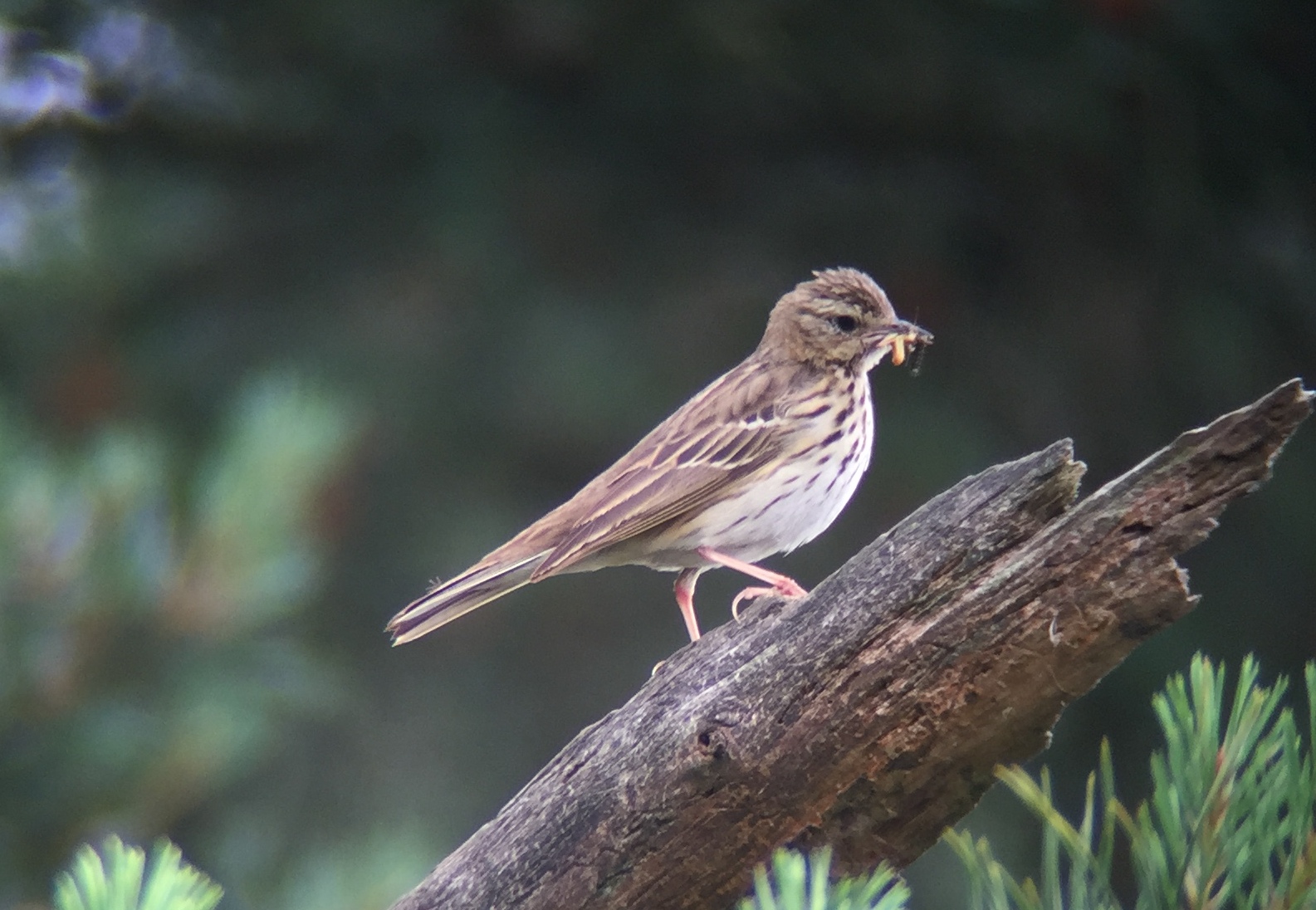 Tree Pipit – up in the pines carrying food for its young
Tree Pipit – up in the pines carrying food for its young
The Tree Pipit was carrying food in its bill, so presumably has young nearby. We left it in peace and retreated. We had intended to go to another site for Tree Pipit after this, but there was now no need. So instead we went round to the other side of the clearing to see if we could find any sign of a Redstart.
It was rather quiet here now, the middle of the afternoon and cool and breezy. A flock of tits moved quickly along the edge of the pines – Long-tailed Tits accompanied by a few Blue and Coal Tits. We flushed a couple of Yellowhammers from the grass, which flew up into the trees nearby. However, the highlight of our walk here was a Woodlark which perched in the top of a small pine briefly in the middle of the clearing.
Our final destination for the afternoon was Lynford Arboretum. We had hoped that there might be more activity here, out of the wind, but it was rather subdued here too. As we walked round, we did find a couple of Nuthatches dropping down to the ground to feed under a small tree and we heard a Treecreeper calling from the wood. There were quite a few Siskins buzzing round the tops of the firs in the Arboretum and a pair came down and landed a little lower where we could see them briefly. A couple of Goldcrests showed themselves too.
We made our way down to the lake. There are always Little Grebes on here and they seemed to have had a good breeding season. As adult was feeding a small juvenile under the overhanging branches just along from the bridge. Further along, 3-4 fully grown juvenile Little Grebes, still sporting stripey faces, were diving among the lily pads.
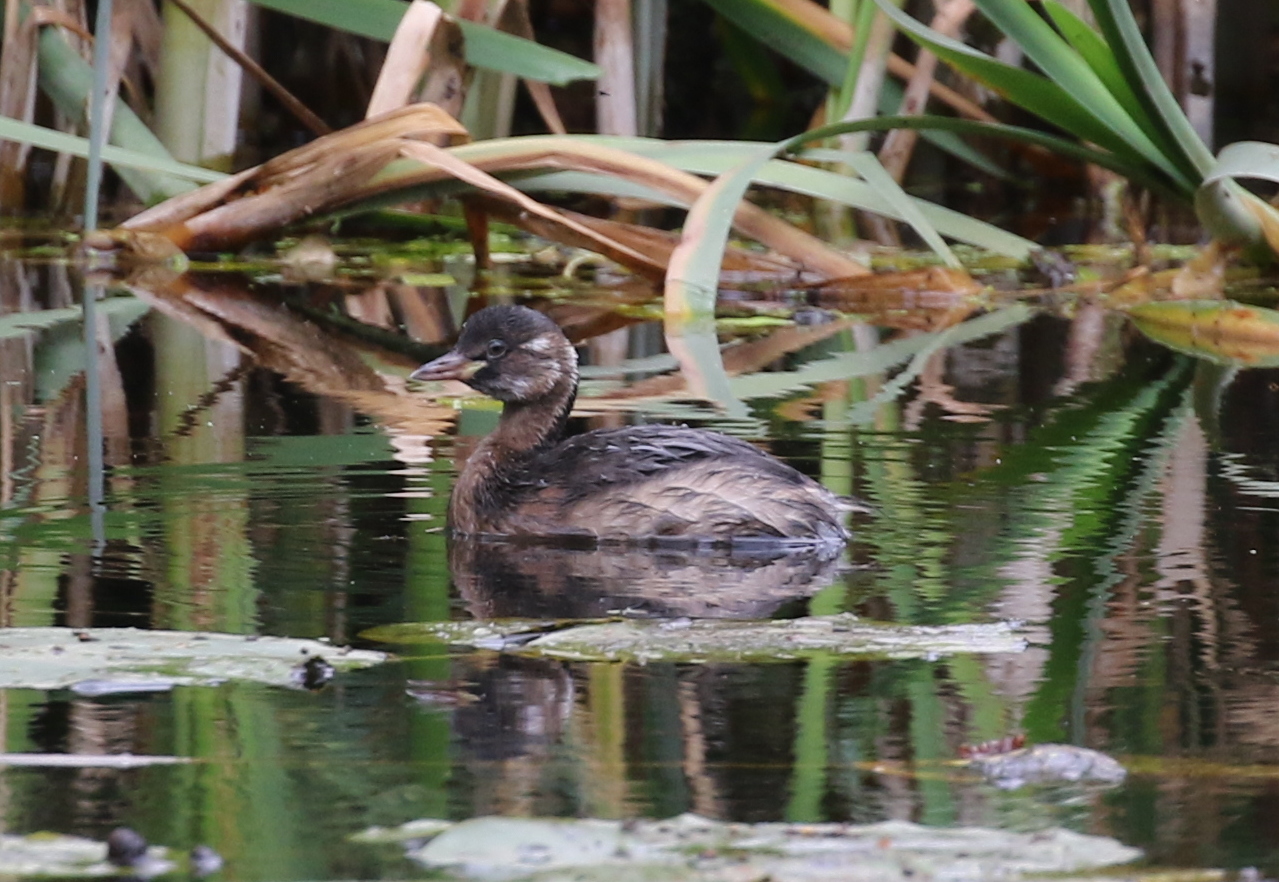 Little Grebe – one of the fully grown juveniles on the lake
Little Grebe – one of the fully grown juveniles on the lake
When we got the end of the lake, we turned and made our way slowly back to the car to finish the day.
















